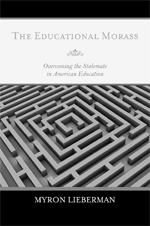 The Educational Morass: Overcoming the Stalemate in American Education.
The Educational Morass: Overcoming the Stalemate in American Education.
Myron Lieberman (Rowman and Littlefield).
The equal-opportunity, granddaddy longlegs of all curmudgeons, Myron Lieberman, manages in one volume to savage teachers unions, education schools, the Education Writers Association, the New York Times, the Washington Post, education research, egalitarian school-choice proponents, and conservatives Diane Ravitch, Terry Moe, Frederick Hess, and Chester E. Finn Jr. A style thought to be reserved for left-wing agitators and trade-union swat teams surfaces from the opposite end of the political spectrum.
Lieberman’s fact-filled, right-handed punches land solidly, entertainingly, time and again, but so pugilistic is the attack dog he forgets his alleged purpose: overcoming the education stalemate. For him, nothing works—neither merit pay, nor test-score accountability, nor alternative certification, nor class-size reduction, nor education schools, nor choices for low-income families. All fall short of the glory of the free-market ideal.
A few positive suggestions nonetheless intrude. Told not to pay good teachers more, we are instead asked to give extra cash to those teaching math and science. Told to be more critical of charter schools, we are asked, in a brief passage, to let them continue.
Lieberman is such a well-read, critical thinker it is a shame he cannot turn off the invective spigot long enough to construct the viable politi cal and policy strategy none other has been able to devise. Unfortunately, Lieberman, in style, cannot escape his own trade-union past, however distant.
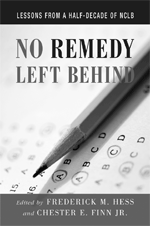
No Remedy Left Behind: Lessons from a Half-Decade of NCLB.
Frederick M. Hess and Chester E. Finn Jr., editors (AEI Press).
Few would dispute the claim that No Child Left Behind needs an overhaul. Yet with the deadline for the law’s on-time reauthorization now past, a consensus about its future has yet to emerge. The bulk of this important book consists of 12 detailed studies of how the law’s mandated remedies for schools identified for improvement are playing out in states and districts across the country. The findings, if unsurprising, are nonetheless sobering: the extent of public school choice has been negligible; participation in supplemental educational services, while rising, remains low; and the law’s restructuring requirements for schools and districts are being deployed in their mildest forms. Confronted with unrealistic goals and an array of legislated loopholes, most local officials have chosen simply to run out the clock. Hess and Finn, in hard-hitting chapters that bookend the volume, call on Congress to set realistic expectations for student performance based on national standards, to provide districts with initial flexibility when intervening in failing schools, but to establish tough consequences for superintendents and principals if those efforts are unsuccessful. Policymakers looking for easy advice heading into 2008 should turn elsewhere. But those seeking to convert NCLB from a utopian mandate into a coherent, workable system for school improvement will find welcome counsel in these pages.

Education for a New Era: Design and Implementation of K–12 Education Reform in Qatar.
Dominic J. Brewer et al. (Rand-Qatar Policy Institute).
Any volume endorsed by Dr. Sheikha Abdulla Al-Misnad, president of the University of Qatar, and Education Next editorial board member Paul Hill calls for a closer look. Here, the RAND team that has been working with the oil-rich Gulf nation Qatar on a radical redesign of the emirate’s education system offers a straightforward account of their handiwork. Detailing Phase I of the RAND-Qatar effort, which spanned 2001–04, the authors explain the creation and implementation of curriculum standards, national testing, independent government-funded schools, annual report cards, and parental choice. They don’t present evidence regarding effects of these initial efforts on student achievement but do explain how RAND diagnosed the weaknesses in the Qatari system, devised the Education for a New Era reform model, and the challenges of implementing standards, independent schools, and the Qatar Student Assessment System. Written in a prose style by turns reminiscent of a government white paper (e.g., “while achieving the goal of free, standardized education is commendable”) and a social studies textbook (e.g., “in 1907, Qatar’s resources consisted of 1,430 camels, 240 horses, and 817 pearl boats”), this slender book is nonetheless packed with interesting information.
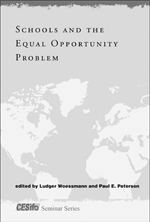
Schools and the Equal Opportunity Problem.
Ludger Woessmann and Paul E. Peterson, editors (MIT Press).
Can schools overcome the highly variable influences of family so that the opportunities of all students are equalized? Since 1966, when the Coleman Report first shined its bright light on the extent of the achievement gap and revealed how little schools were doing to ameliorate it, school reformers have sought ways to raise the educational achievement of disadvantaged students and researchers have analyzed these efforts. The 11 papers in this conference volume were contributed by American and European researchers who marshaled the tools of economic analysis to assess recent efforts to close the achievement gap in the U.S. and abroad. These reforms fall under three headings: changing the peer group, refocusing resources, and implementing standards and choice. The Coleman Report identified the peer group at school as an important factor affecting learning, but several papers in this volume suggest that the socioeconomic status or academic ability of peers has little effect on academic performance. Other papers cast doubt on the premise that focusing additional material resources on disadvantaged students will raise their academic outcomes; in one paper, Julian Betts and John Roemer estimate that schools would need to spend 8 to 10 times as much money on the education of blacks as whites to achieve equity across racial groups. On the other hand, exit exams and higher graduation requirements may raise academic achievement, and properly designed choice programs may also help disadvantaged students. The chapters in this book raise as many questions as they answer, leaving the door open for many future conferences and books on this topic.
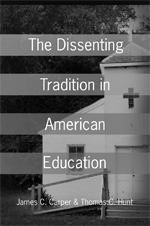
The Dissenting Tradition in American Education.
James C. Carper and Thomas C. Hunt (Peter Lang Publishing).
American education has a long and well-documented history of dissenters. During the past 25 years, education historians James C. Carper and Thomas C. Hunt separately have published many essays on 19th-century Catholic and Protestant public school opponents; they have also analyzed recent home-schooling initiatives and written about private Christian day schools. This new book brings together material from eight previously published articles as well as a chapter on the bishop of New York City, John Hughes (1797–1864). The essays cover 19th-century Catholic and Protestant opposition to public schools, including Bishop Hughes’s efforts to obtain public monies for Catholic schools and those of church leaders to encourage their parishioners to create alternative parochial schools rather than send their children to secular public schools.
The “final thoughts” chapter provides some of the most intriguing and intellectually challenging contributions of the book. As they ponder the future of dissent in American education, the authors note that “in some respects the current educational landscape, with its diversity of options, is starting to resemble the landscape of pre-common-school America.” They also consider whether “the time [today] is indeed ripe for Americans to consider, in the words of authors Rockne McCarthy, James Skillen, and William Harper, ‘Disestablishment a Second Time.’”
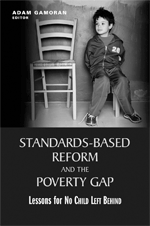
Standards-Based Reform and the Poverty Gap: Lessons for No Child Left Behind.
Adam Gamoran, editor (Brookings Institution Press).
This conference volume has an identity crisis. Its marketers clearly want to ride the No Child Left Behind (NCLB) wave, but at least half of the book (the more interesting half!) is only marginally related to the federal law. Consider Meredith Phillips and Jennifer Flashman’s examination of standards-based reform in the 1990s, which finds evidence that testing and accountability can change teacher behavior in positive ways. Or look at the dandy of a chapter by Thomas Dee and Brian Jacob, which studied the impact of high school exit exams—not required by NCLB—on various student outcomes, including college completion and future earnings. Their bottom line: these tests, by and large, depress high school graduation rates while failing to predict success in college or work. Still, the effort provides at least a few morsels for the NCLB-obsessed. Tom Loveless pens a provocative piece on the politics of the federal law, finding support for NLCB strongest among minorities and the middle class. It’s a worthwhile read, just not cover to cover.


